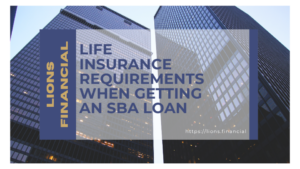Lions Financial helps Financial Institutions and Businesses, together with their tax and legal advisors, during the Due Diligence and Valuation period to make the optimal financial decisions for success. We have compiled a brief overview In a leveraged buyout (LBO), the capital structure refers to the way the purchase of a company is financed, typically with a combination of debt and equity.
In the capital structure of leveraged buyout (LBO), the target company’s existing debt is usually refinanced (although it can be rolled over) and replaced with new debt to finance the transaction. Multiple tranches of debt are commonly used to finance LBOs, and may including any of the following tranches of capital listed in descending order of seniority:
A revolver is a form of senior bank debt that acts like a credit card for companies and is generally used to help fund a company’s working capital needs. A company will “draw down” the revolver up to the credit limit when it needs cash, and repays the revolver when excess cash is available (there is no repayment penalty). The revolver offers companies flexibility with respect to their capital needs, allowing companies access to cash without having to seek additional debt or equity financing.
There are two costs associated with revolving lines of credit: the interest rate charged on the revolver’s drawn balance, and an undrawn commitment fee. The interest rate charged on the revolver balance is usually LIBOR plus a premium that depends on the credit characteristics of the borrowing company. The undrawn commitment fee compensates the bank for committing to lend up to the revolver’s limit, and is usually calculated as a fixed rate multiplied by the difference between the revolver’s limit and any drawn amount.
Bank debt is a lower cost-of-capital (lower interest rates) security than subordinated debt, but it has more onerous covenants and limitations. Bank debt typically requires full amortization (payback) over a 5- to 8-year period. Covenants generally restrict a company’s flexibility to make further acquisitions, raise additional debt, and make payments (e.g. dividends) to equity holders. Bank debt also has financial maintenance covenants, which are quarterly performance tests, and is generally secured by the assets of the borrower. Existing bank debt of a target must typically be refinanced with new bank debt due to change-of-control covenants.
Bank debt, other than revolving credit facilities, generally takes two forms:
Term Loan A ? This layer of debt is typically amortized evenly over 5 to 7 years.
Term Loan B ? This layer of debt usually involves nominal amortization (repayment) over 5 to 8 years, with large bullet payments in the last year. It also allows borrowers to defer repayment of a large portion of the loan but is more costly to borrowers than Term Loan A.
The interest rate charged on bank debt is often a floating rate equal to LIBOR plus (or minus) some premium (or discount), depending on the credit characteristics of the borrower. Depending on the credit terms, bank debt may or may not be repaid early without penalty.
High-yield debt is typically unsecured. High-yield debt is so named because of its characteristic high-interest rate (or large discount to par) that compensates investors for their risk in holding such debt. This layer of debt is often necessary to increase leverage levels beyond that which banks and other senior investors are willing to provide, and will likely be refinanced when the borrower can raise new debt more cheaply. Subordinated debt may be raised in the public bond market or the private institutional market, carries a bullet repayment with no amortization, and usually has a maturity of 8 to 10 years.
A company retains greater financial and operating flexibility with high-yield debt through incurrence, as opposed to maintenance, covenants and a bullet (all-at-once) repayment of the debt at maturity. Additionally, early payment options typically exist (usually after about 4 and 5 years for 7- and 10-year high-yield securities, respectively), but require repayment at a premium to face value. Interest rates for these securities are higher than they are for bank debt.
The interest on high-yield debt may be either cash-pay, payment-in-kind (“PIK”), or a combination of both. Cash-pay means that coupon is paid in cash, like the interest on bank debt. PIK means that the issuer can pay interest in the form of additional high-yield debt, so as to increase the face value of the debt that must ultimately be repaid. Sometimes, high-yield debt is structured so that the issuer may choose between cash-pay and PIK (the PIK option is usually more attractive to the issuer). Also, the mezzanine debt may be structured so that the PIK option is available for the first few years of the debt’s life, after which cash-pay becomes mandatory.
The mezzanine ranks last in the hierarchy of a company’s outstanding debt, and is often financed by private equity investors and hedge funds. Mezzanine debt often takes the form of high-yield debt coupled with warrants (options to purchase stock at a predetermined price), known as an “equity kicker”, to boost investor returns to acceptable levels commensurate with risk. For example, regular subordinated debt might have an interest rate of 10%, while a hedge fund investor expects a return (IRR) in the range of 18-25%. To bridge this gap and attract investment by the hedge fund investor, the borrower could attach warrants to the subordinated debt issue. The warrants increase the investor’s returns beyond what it can achieve with interest payments alone through appreciation in the equity value of the borrower.
The debt component has characteristics similar to those of other junior debt instruments, such as bullet payments, PIK, and early repayment options, but is structurally subordinate in priority of payment and claim on collateral to other forms of debt. Like subordinated notes, mezzanine debt may be required to attain leverage levels not possible with senior debt and equity alone.
A portion of the purchase price in an LBO may be financed by a seller’s note. In this case, the buyer issues a promissory note to the seller that it agrees to repay (amortize) over fixed period of time. The seller’s note is attractive to the financial buyer because it is generally cheaper than other forms of junior debt and easier to negotiate terms with the seller than a bank or other investors. Also, the acceptance of a seller’s note by the seller signals the seller’s faith and confidence in the business being sold. However, seller financing may be unattractive to the seller because the seller retains the risks associated with the business without having any control over it. Moreover, the seller’s receipt of proceeds from the sale is delayed.
Securitization of the cash flows attributable to particular assets, such as receivables or inventory, may provide another source of financing when a secondary market for securitization of such assets exists.
Equity capital is contributed through a [private equity] fund that pools capital raised from various sources. These sources might include pensions, endowments, insurance companies, and wealthy individuals.
| Source of Funds | Key Terms | Comments | ||
| Bank Debt |
|
|
||
| High-Yield and Subordinated Debt |
|
|
||
| Mezzanine Debt |
|
|
||
| Total Debt |
|
|
||
| Common Equity |
|
|
||
Early Repayment Penalties
When a borrower repays its loans early, the lender must reinvest the repayments to earn acceptable returns. However, there is some risk that the lender will be unable to loan money on terms equivalent or better than it obtained from the borrower who is repaying early if, for example, interests rates may have declined since the lender originally made the loan to the borrower. To mitigate this risk, lenders sometimes charge borrows a premium to repay their loans early.
Credit Statistics
When considering an appropriate capital structure for an LBO transaction, is it very important to target realistic credit statistics. Credit statistics that are calculated as a multiple of interest expense are called “financial coverage” ratios.
| Parameter | Typical Value* | |
| Total Debt / EBITDA | 4.5x – 5.5x | |
| Senior Bank Debt / EBITDA | 3.0x | |
| EBITDA / Interest Coverage | > 2.0x | |
| (EBITDA ? CapEx) / Interest Coverage | > 1.6x | |
* These parameters will change with market conditions. Consult the leveraged finance group at an investment bank for current parameters. Also, the financing limit will depend on the circumstances specific to the transaction and the growth potential of the target.
Sources & Uses
The pro forma capitalization and transaction structure are set forth in the “sources and uses” of funds. The sum of the sources of funds must always equal the sum of the uses of funds. Any debt or equity is “rolled over” appears as both a source and use of funds. The table below provides examples of sources and uses of funds:
| Sources | Uses | |
| Excess cash | Purchase of equity | |
| Debt assumed by the buyer | Investor roll-over | |
| Minority interest assumed | Fund target’s cash balance | |
| Revolver | Assumed (roll over) debt | |
| Term Loan A | Refinance short-term debt | |
| Term Loan B | Refinance long-term debt | |
| Senior notes | Assume (roll over) minority interest | |
| Mezzanine preferred stock | Purchase (buy out) minority interest | |
| Subordinated (high-yield) notes | Transaction fees and expenses | |
| Mezzanine debt | Financing fees | |
| Seller notes | ||
| Preferred stock | ||
| Common equity (sponsor’s investment) | ||
| Management equity roll-over | ||
| Investor roll-over | ||
The capital structure of an LBO is designed to maximize the return on investment for the private equity firm or investor while minimizing the amount of cash needed to acquire the target company. However, a highly leveraged capital structure can also increase the risk of default or bankruptcy if the target company is unable to generate sufficient cash flow to service its debt obligations. Therefore, careful consideration and analysis of the target company’s financial condition and prospects are crucial in determining an appropriate capital structure for an LBO.
However, it is important to keep in mind that valuing a startup is not an exact science, and the actual value may differ from the estimated value due to various factors, including market conditions and future events.
If you are seeking specific information on the services offered by Lions Financial. Please Schedule a call with us to get the assistance you need!
Author
-

Keith focuses on providing business advisory and capital markets support services. To domestic USA, foreign-based, and multinational clients: both privately and publicly held (including state-owned) client enterprises. Of all sizes: Big, middle-market, small and medium-size. On the business advisory side: Keith develops optimization plans for clients' enterprises. And then supports the implementation of these plans. Through all phases of mergers and acquisitions activity: pre-deal, during-deal, post-deal. On the capital markets side: Keith supports buy-side and sell-side clients' capital raise, capital deployment, and mergers and acquisitions deal value stewardship initiatives. Through all rounds: from Seed, Series A, B, C, D, E, etc. pre-Initial Public Offer, IPO, and Follow-on Public Offer. To do so, he works with venture capital (including angels and family offices), private equity, and institutional investment providers. Also, debt capital providers: government agency, banks, mezzanine, and mortgage loan providers. Keith also works with legal, accounting, valuation, and underwriting specialist professionals. Bringing his blend of wide business and financial experience, and focused skills with relevant supporting data. Prior to joining Lions Financial: Keith enjoyed a 50+ year career as a business-to-business and business-to-consumer marketing professional. Starting out as a freshly minted MBA entry-level management trainee. Then rising through the ranks. To Chief Executive Officer and President. Keith worked on the client, agency, and marketing services provider side. He has worked in 28 countries worldwide. And has category experience across multiple industry sectors: including airlines, automotive, consumer packaged goods, energy, financial services (retail and commercial banks, credit and charge cards, insurance, real estate), health and beauty aids, healthcare (biotech, pharmaceutical, medical devices and diagnostic products, insurance payers, hospitals and clinics, pharmacies), hospitality (hotels and resorts), liquor, media and publishing (broadcast, Internet, print), retail (including e-tail), technology (hardware and software, telecommunications). Keith pivoted to focus on financial services over the past 12+ years, starting out at MetLife, then New York Life, to Lions Financial. Keith is a graduate of Bombay Scottish High School, an academically elite private school. And the University of Mumbai. His undergraduate studies focused on economics with statistics as his major. And his graduate studies focused on marketing with finance. Over the subsequent course of his career, Keith subsequently got various post-graduate professional certificates and licenses. Including advanced marketing, account planning, media planning and buying, negotiation skills, insurance and investments. Keith is a 30+ year resident on the Upper East Side, Manhattan.














